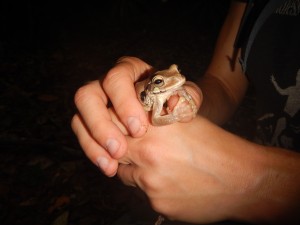Today we focused on some of the many ant species that habitate the Chiquibul forest. The cecropia tree has a symbiosis with azteca ants, which protect the tree from predators in exchange for shelter and food. We spent the morning testing a few hypothesis about how the cecropia trees avoid herbivores before they are colonized by the protector ants.
This afternoon we excavated three leaf cutter ant colonies of different maturities. Once a queen colonizes a nest after a nuptial flight she can live for 20 years reproducing, expanding the colony until there are millions of ants at any given time. There are tunnels underground leading to chambers full of the ant’s fungus garden and pupae. The youngest ones are fairly small, but once they are 10 years old they get huge, with tunnels the width of your arm full of soldier ants ready to come out and attack you when you disturb them. They have quite a pinch and we were all thankful for our rubber boots today.
We had an unexpected amphibian sighting once we got back to our housing; one of the bedrooms had a large frog on a bedpost. I caught it and took it outside to get a closer look and try to identify it. It hiccuped in my hand, puffing out its chest, in protest to its capture. The frog was dark green and brown, with some stripy markings around the forelegs. I couldn’t examine its back without it jumping from my hands so I didn’t get a clear look. It was about 2.5 inches long with horizontal pupils, bronze irises and toe pads. The toe pads indicate that its a treefrog and since there aren’t many in the area I would have to guess that it was another common Mexican treefrog, based on size and color. I released it into the trees after a minute or two to not cause it too much distressed and it leapt from my hands with a defiant squeak.
Sophia Streeter
5-20



